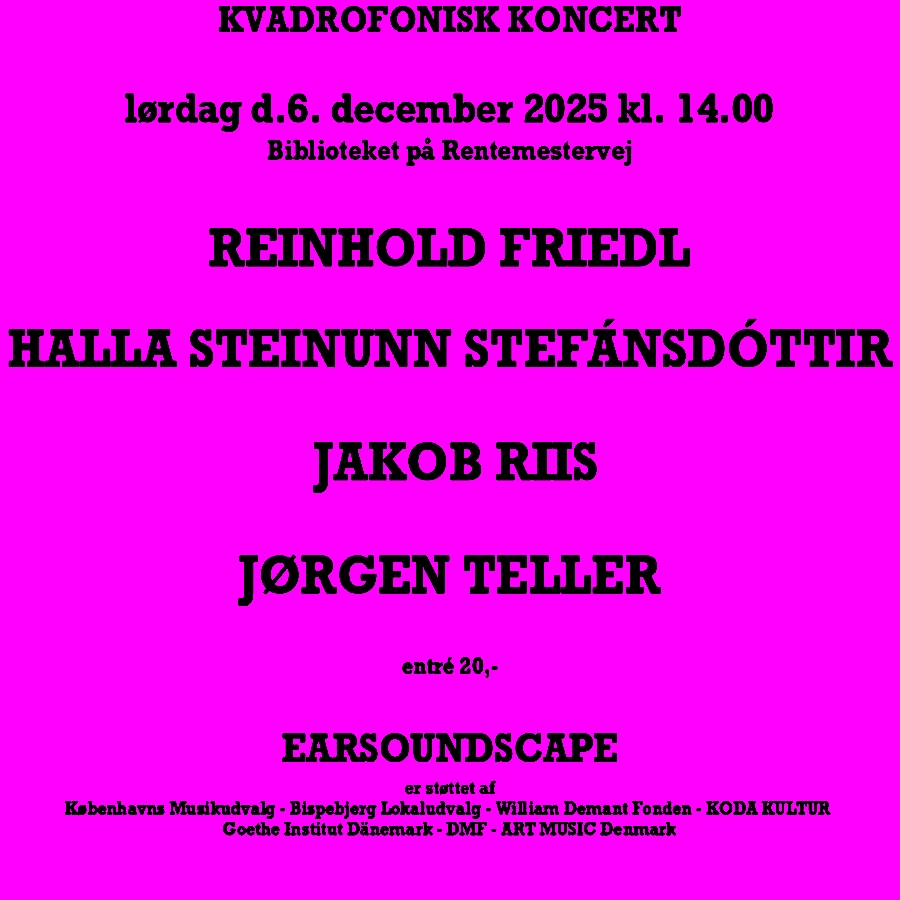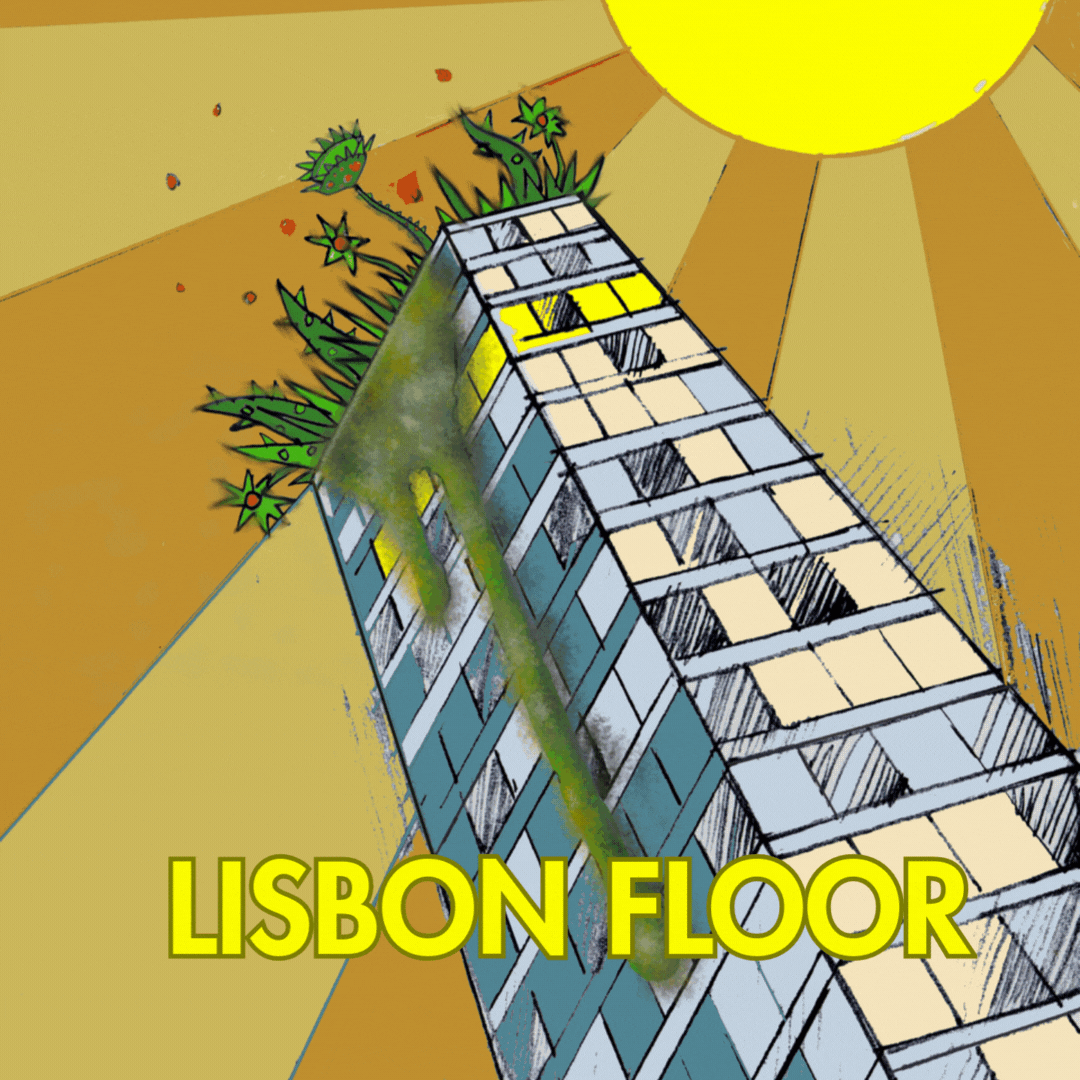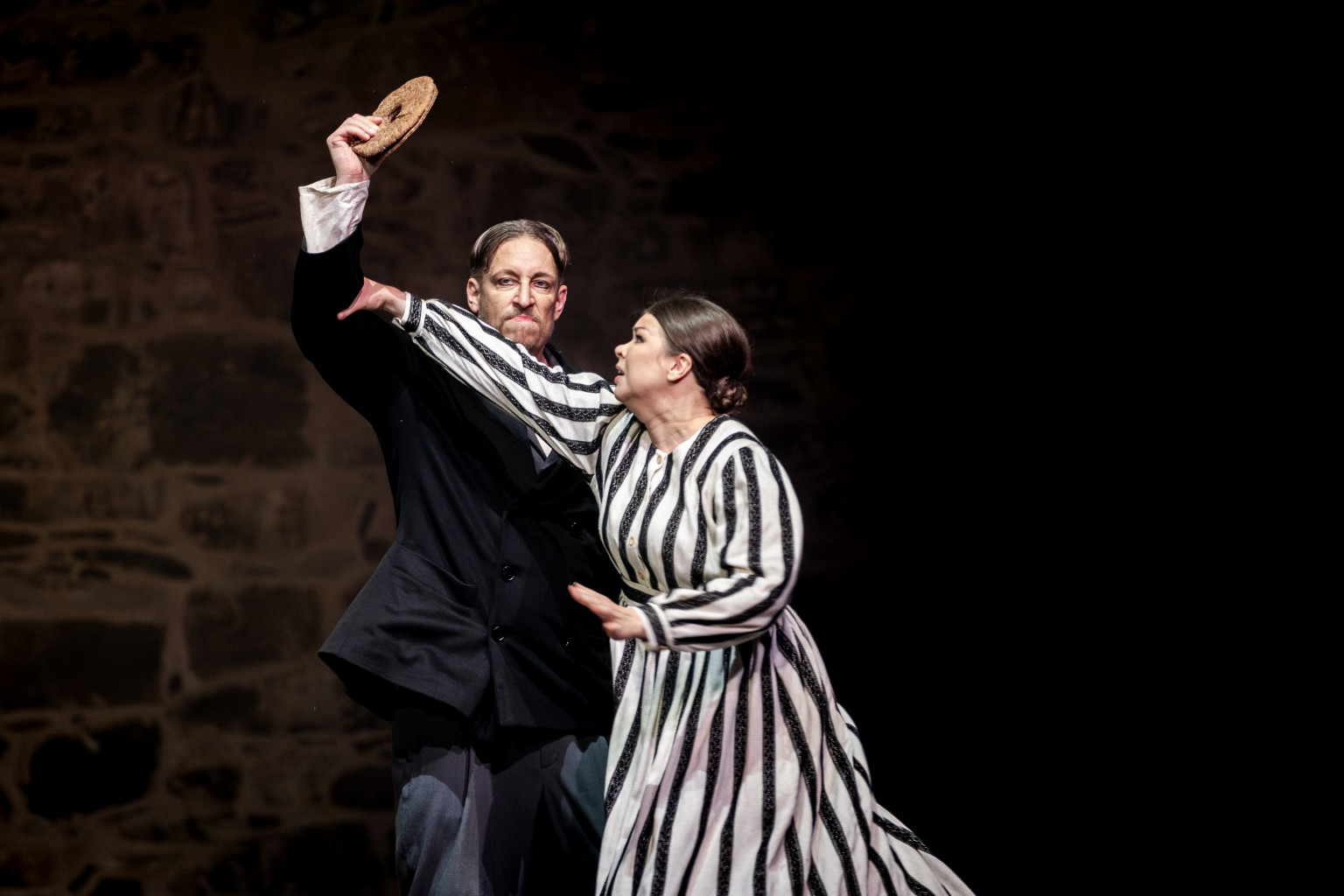
Opera’s Darkness Finds a Home in Savonlinna
Super-idyllic Savonlinna lies deep inside Finland – four hours by bus from Helsinki or a short 45-minute flight. A postcard-perfect town in the midst of some of the country’s most beautiful nature, where lakes, islands, and forests endlessly flow into one another. On a small island rises a raw yet well-preserved medieval castle, perfectly sized to hold a stage and more than 2,000 audience members in its courtyard. That was precisely why the idea for an opera festival emerged here in 1912 – one of the oldest of its kind in the world.
In Denmark, our national opera is about four silly youngsters sneaking carefree into The Masquerade. In Finland, they take a different angle on life
Opera can be many things – affected, extremely moving, snobbish, tear-inducing, dreadfully boring, or simply too much. This very range makes it the most fascinating – and the most expensive – of all the musical art forms. The question is whether it makes a particular difference that a production takes place in such picturesque and historically authentic surroundings, or whether the castle merely functions as decorative scenery, adding a feel-good effect for an exclusive audience enjoying their white wine with extra pleasure during intermission at a genuine medieval fortress.
Two productions at this summer’s Savonlinna Festival provided a clear answer. Especially the Finnish national opera Viimeiset Kiusaukset (The Last Temptations) from 1975.
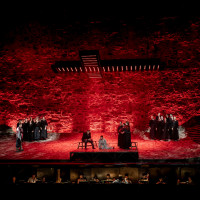
In Denmark, our national opera is about four silly youngsters sneaking carefree into The Masquerade. In Finland, they take a different angle on life: The Last Temptations tells the story of a dark-minded preacher on his deathbed, reflecting on the terrible things he has caused those around him – doubting whether he will be granted forgiveness at heaven’s gate. Compellingly and competently set to music by Joonas Kokkonen. It’s an atmosphere of existential and spiritual crisis, marked by a remarkable absence of earthly love: no trace of people torn apart by romance, or dying for their beloved. This opera is dark and profoundly spiritual in character – about guilt, shame, and the search for reconciliation or inner peace. And the Finns love it.
Deliciously dark: guilt upon guilt
The lay preacher Paavo Ruotsalainen lies on his deathbed, as memories flow between reality and hallucination. He relives the conflicts with his late wife Riitta, the grief over the death of his son Juhana, and his relentless drive to follow his calling – despite mockery from the clergy and the world around him. Was his life’s work worth the suffering? And will he at last find peace on the holy island – heaven’s gate, eternity?
The mood is distilled in a dialogue late in the first act: When neighbors tell Paavo and Riitta that their son has been found dead – killed by his own hand, no less – they wonder why Riitta does not react. »I have already cried for three years,« she replies. Paavo breaks into song about how God has whipped him all his life with an iron scourge – and that he deserved it.
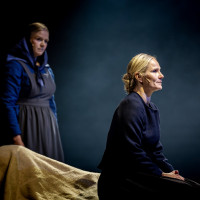
Joonas Kokkonen spent 16 years writing the opera, and one senses dramatic inspiration from Alban Berg (Wozzeck/Lulu). Musically, the closest parallels are Richard Strauss or the Czech composer Janáček, though The Last Temptations does not contain the same harmonic complexity. Kokkonen’s tone is both unpretentious, memorable, and original, though he repeats certain harmonic and melodic progressions a bit too often. Yet it all serves the mood-building – and dark – element of the opera. A hymn plays a central role throughout. Two women sing it to Paavo at the beginning to lull him into calm; it reappears midway, and finally at the end, when the dying protagonist sings his modal-minor hymn and the surrounding characters join in. The orchestra follows, and it is this hymn that lingers in the audience’s mind as they walk together, thousands strong, across the small bridge away from the beautiful castle.
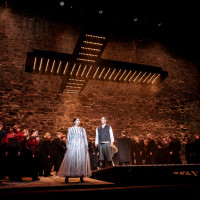
Light as a fellow player
The uplifting aspect of Mikko Kouki’s staging is above all the use of light as a symbolic force and the strong character direction. A large LED-lit cross hangs horizontally, facing downward from the start, slowly lowered closer to the characters as they come under greater pressure. After the intermission between the opera’s two acts, the cross lies flat on the stage, for the characters to walk upon. A brilliant scenic effect – given the central role of the Christian cross in the drama. Paavo’s self-imposed burden is shown concretely: he begins in only a thin shirt, but gradually dons more layers – a vest, then a heavy sweater, then a coat. He is weighed down, inwardly and outwardly.
The way the red light fractures against the stone wall could not have been created by any scenographer
A massive raw stone wall forms the backdrop, serving perfectly as a canvas for light that creates varying color temperatures, angles, and irregular shadows. Here, the medieval castle’s setting truly shines: when the stage is bathed in cool blue hues, the action takes on a dreamlike quality, and the characters appear as shadows or visions. A blue hue illuminates Paavo’s recollections – a life between reality and memory – signaling the transition between life and death. The color’s coldness, introspection, and transcendence mirror his spiritual state and give the audience a near-meditative access to his inner struggle.
Warm, earthy tones work even better with the rugged stone wall, used when the community or »the people« are in focus – such as when Paavo meets Riitta at a dance (and others mock him and warn her against engaging with the strange and ominous man). These tones point to everyday human life in contrast to the blue vision scenes.
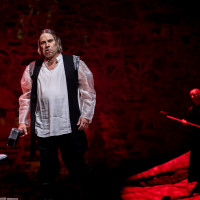
But the sensual red tones are the most striking in the castle space – underscoring passion, anger, fervor (for faith!), and perhaps human desire. As when Paavo takes his son’s backpack and the family’s last food to go out and preach (he is hardly a man of kindness), or when Riitta hurls an axe across the room at him. The way the red light fractures against the stone wall could not have been created by any scenographer; the raw, almost fleshy symbolism is extremely powerful.
His bass has a rare fullness and power, seldom heard on Danish stages
Blue returns in the archetypal death scene, where Paavo is surrounded by the mournful, spiritual presence of others. The image recalls the last hours of saints or Christ’s Passion, elevating his fate to near-martyr status. Repeated references to »heaven’s gate« and the calls of »Come to the island!« from the deceased Riitta and Juhana underscore the transition into eternity. The castle’s massive opening becomes heaven’s very gate, through which Paavo walks toward salvation and inner peace.
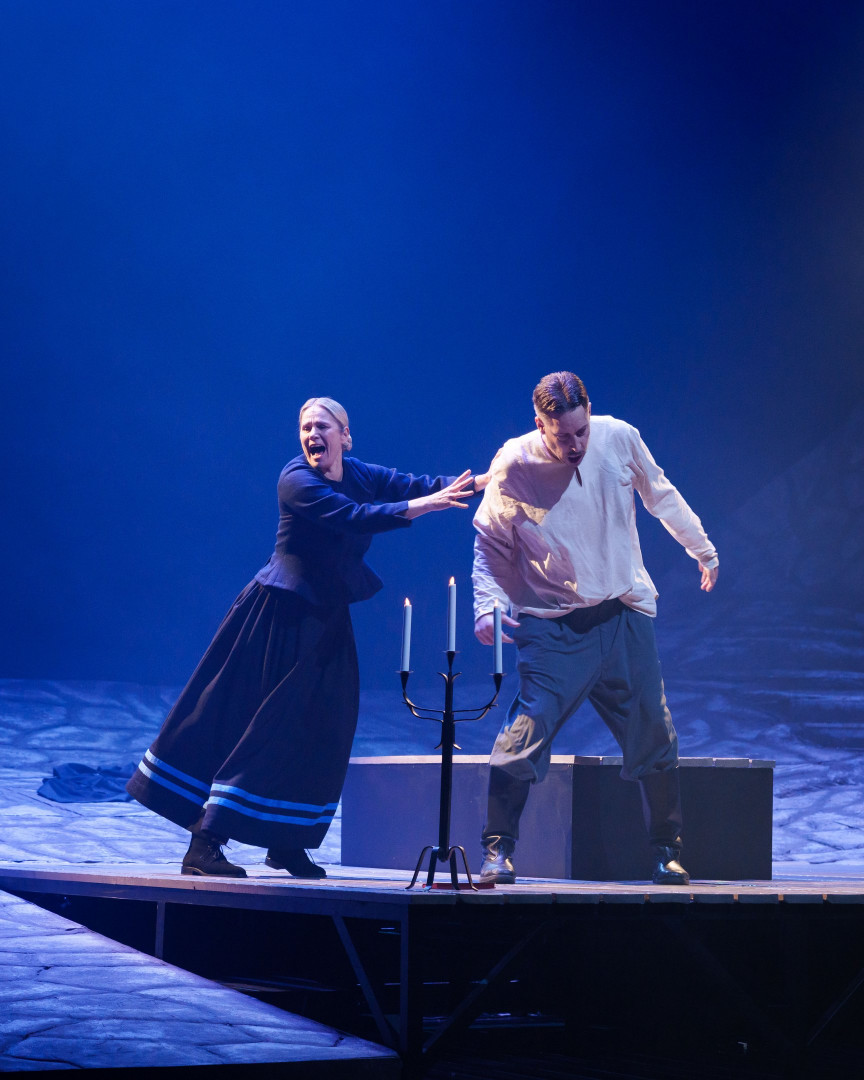
Voices against the stone wall
The castle courtyard produces a unique acoustic: the singers’ voices bounce between the stone walls, amplified and sent clearly back to the audience. The balance between orchestra and singers is almost better than in a traditional opera house, and the Finnish language stands out distinctly – accompanied by English surtitles. Mika Kares as Paavo is especially impressive. His bass has a rare fullness and power, seldom heard on Danish stages. He alone is worth the journey.
Stone, voices, and symbolism merge into spiritual opera art
The festival orchestra under Ville Matvejeff plays with precision, free from the supercilious gesturing one sometimes encounters in Wagner. The music does not comment on the drama but supports it loyally. Instead, the lighting design functions as a kind of inner voice: it signals whether we are in memory, vision, or concrete reality, adding an extra dimension. Here Kokkonen’s opera unfolds in full – in a space where stone, voices, and symbolism merge into spiritual opera art.
The same cannot be said for the guest performance from Perelada in Spain, which the evening before presented their somewhat cut version of Purcell’s The Fairy Queen. This »semi-opera« originally combined Shakespeare’s A Midsummer Night’s Dream with Purcell’s musical interludes.
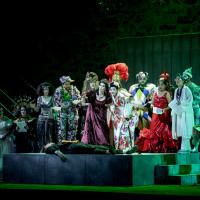
Director Joan Anton Rechi in Savonlinna had removed all the spoken play, leaving only a fragmented and less meaningful sequence of music. But perhaps the greatest error was that the production barely related to the space they stood in, missing the magnificent possibilities the castle setting could provide.
The festival becomes a rare and successful meeting of place, history, and art
Opera in a postcard town – a meeting with the Finnish soul
The Finns are hardly more religious than other northerners, yet The Last Temptations touches something particular in the Finnish soul: Paavo’s inner struggle, the dark sides of existence, and the yearning for reconciliation and transcendence. Its distinctive music and existential themes open a resonant window into a culture otherwise hard to glimpse. Combined with the raw nature surrounding idyllic Savonlinna and its medieval castle, seemingly made for opera, the festival becomes a rare and successful meeting of place, history, and art.
Opera can be many things – but only when a director and an ensemble take the space seriously does it become an art that reaches back through history and gives us a glimpse of another country’s culture and soul. And you may consider the white wine in the castle courtyard as a bonus.
Savonlinna Opera Festival, Savonlinna, Finland, July 4 – August 2
English translation: Andreo Michaelo Mielczarek. Proofreading: Seb Doubinsky
